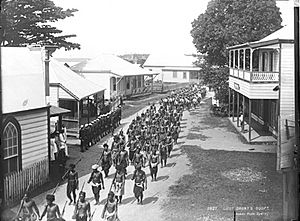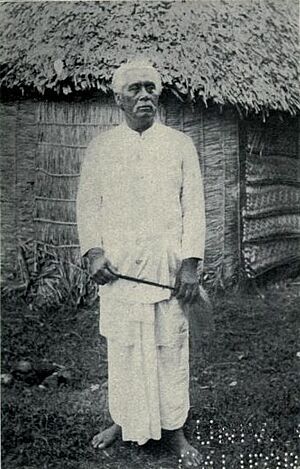Second Battle of Vailele facts for kids
The Second Battle of Vailele happened in 1899 during the Second Samoan Civil War. In this battle, soldiers from the British, American, and Samoan armies who supported Prince Tanu were defeated. They fought against a larger group of Samoan rebels who followed Mata'afa Iosefo. The fighting took place at a plantation in Vailele, Samoa. It was an important fight in this small war.
Quick facts for kids Second Battle of Vailele |
|||||||
|---|---|---|---|---|---|---|---|
| Part of the Second Samoan Civil War | |||||||
 Samoan warriors marching through Apia in March of 1899, American sailors and marines are inspecting at the left. |
|||||||
|
|||||||
| Belligerents | |||||||
| Allies: |
Supported by: |
||||||
| Commanders and leaders | |||||||
| Strength | |||||||
| Land: 136 warriors 26 marines 88 sailors Sea: 1 corvette |
~800 warriors 2 forts |
||||||
| Casualties and losses | |||||||
| 7-10 killed 7 wounded |
~50-100 killed or wounded 2 forts damaged |
||||||
Contents
Why the Battle Happened
In 1899, Samoa was a place of war. This had been true before, during the First Samoan Civil War. The latest conflict started when the Samoan ruler, Malietoa Laupepa, died.
Choosing a New Leader
After Malietoa Laupepa's death, Mata'afa Iosefo came back from being sent away. A group of Samoan chiefs chose him to be the new leader. However, the British and American navies did not agree with this choice. They supported Prince Tanu, who they believed was the rightful heir to the Samoan throne.
First Fights in Apia
British and American navy forces landed in Apia, the capital city. They took control of much of the city. Mata'afa's forces then attacked them. In response, British and American warships in Apia Harbour fired their cannons at enemy positions around the city. After this fight, Mata'afa's fighters moved back to their strong base at Vailele.
Journey to Vailele
British and American soldiers then went into the thick jungle to find Mata'afa's men. At the end of March, a group of British, American, and Samoan forces marched from Apia towards Vailele. They had small fights along the way. Two villages were destroyed as the Samoan rebels moved back.
On April 1, the soldiers left the coast to attack Vailele from the land side. This meant they would no longer have help from the navy's big guns. The group included 26 marines, 88 sailors, and 136 Samoans. Warships like the USS Philadelphia, HMS Tauranga, HMS Porpoise, and HMS Royalist had brought the sailors and marines. The Royalist went ahead to fire at two forts that protected the Vailele plantation.
The Battle Begins
As the soldiers got close to the plantation, HMS Royalist stopped firing its guns. Suddenly, Mata'afa's forces attacked the land group. About 800 riflemen were hidden in the jungle plants. The land force was led by British Lieutenant Angel Hope Freeman and American Lieutenant Philip Lansdale.
Surprise Attack
The soldiers quickly started shooting back. The Americans set up a Colt machine gun. Mata'afa's fighters first attacked the allied group from behind and from the left side. Lieutenant Freeman was killed and beheaded right after the fighting began. He was shot by snipers hiding among the palm and banana trees.
Fierce Fighting
The rebels then charged forward. Lieutenant Landsdale took command of the allied forces. Close-up fighting continued for a while. The rebel Samoans kept attacking the front line of the allied group. Many of them were killed or wounded.
The machine gun stopped working after only a few shots. As Lieutenant Landsdale tried to fix it, he was shot in the leg. The bone in his leg was shattered, and he fell down. A signal was given to retreat. Landsdale told his men to save themselves. The soldiers began to fall back, leaving the lieutenant alone under heavy fire.
Heroic Actions
Ensign John R. Monaghan refused to leave his commander. He picked up a rifle and, with three other men, went back for Landsdale. As they were carrying him away, Seaman Norman Edsall was shot and killed.
Landsdale again told his rescuers to leave him, but they stayed. They waited for more help but were killed by the quickly approaching Samoan rebels. After the battle, Landsdale and Monaghan were found dead next to each other.
Counting the Losses
The allied group retreated to the coast. They had many casualties, which they counted the next morning. As they pulled back, HMS Royalist started firing again. It shot at the bushes where Mata'afa's men were attacking from.
Mata'afa's rebel forces lost about 100 men killed or wounded. The allied group had fewer casualties. Out of 56 American sailors and marines, four were killed and five were wounded. The British lost three men killed out of 62 soldiers. Two others were wounded. The Samoan soldiers fighting with the Americans had very few, if any, casualties. Most of them ran away when the first shots were fired. The remaining ones were used to help the front line.
Later, patrols found large pools of blood behind the banana trees. This showed how many rebels had been hurt. Two marine privates, Henry L. Hulbert and Michael Joseph McNally, received the Medal of Honor for their brave actions during the fight.
After the Battle
The battle was a defeat for the allied forces. They went back to Apia and told their commanders about their losses. The commanders then planned for future actions in the area.
On April 13, the British front line was moved south of Vailele. That day, Mata'afa's forces attacked but were pushed back. Another group later fought again in Vailele. This time, the rebels won again. They held strong against a British-led attack on the two forts.
These fights happened near the same place where Samoan rebels had defeated German troops in 1889. That was during the first civil war on the island. A statue of Ensign Monaghan was put up in Spokane, Washington. It was built to remember the young officer's bravery. The official report about Monaghan's death said:
- "The men were not in sufficient numbers to hold out any longer, and they were forced along by a fire which it was impossible to withstand. Ensign Monaghan did stand. He stood steadfast by his wounded superior and friend - one rifle against many, one brave man against a score .... He knew he was doomed. He could not yield. He died in heroic performance of duty."


